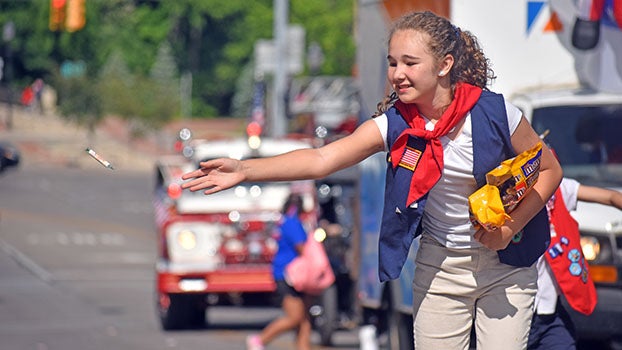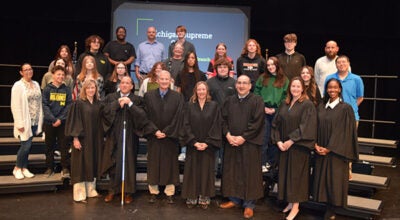Keeping in eye on the skies
Published 8:23 pm Friday, October 7, 2011

Daily Star photo/JOHN EBY Herb Teichman of Eau Claire strikes the same pose as his father, William, did in 1967 when he won the National Oceanic and Atmospheric Administration of the U.S. Department of Commerce National Weather Service Thomas Jefferson Award for outstanding service in the Cooperative Weather Observer Program. Only five of 11,000 cooperative weather observers around the country receive the prestigious award created in 1959.
EAU CLAIRE — In recognition of 43 years of service to America, the National Oceanic and Atmospheric Administration (NOAA) of the U.S. Department of Commerce honored Berrien County fruit farmer Herbert F. Teichman Wednesday afternoon with a 2011 Thomas Jefferson Award.
The prestigious award, for outstanding service in the Cooperative Weather Observer Program, is awarded to only five volunteers in the nation.
Teichman, 81, and a 1948 Dowagiac graduate, follows his father, from whom he took over the weather station in 1968.
William W. Teichman, who had been the National Weather Service’s official observer four miles northeast of Eau Claire since 1923, received his own Jefferson recognition in the summer of 1967.
“Cooperative observers are the bedrock of weather data collection and analysis,” according to Dr. Jack Hayes, director of NOAA’s National Weather Service, of which Cass and Berrien are five Michigan counties aligned with northern Indiana.
“Satellites, high-speed computers, mathematical models and other technological breakthroughs have brought great benefits to the nation in terms of better forecasts and warnings. But without the century-long accumulation of accurate weather observations taken by volunteer observers, scientists could not begin to adequately describe the climate of the United States. We cannot thank Mr. Teichman enough for his years of service to America.”
Teichman, ironically, uses an old-fashioned pencil to hand-write his data into a booklet he submits monthly — it hit 82 Oct. 5, the orchard air thick with ladybugs; Oct. 4 saw a high of 75, a low of 44 and 65 at the time of his observation, which is a 6 p.m. ritual going back to when it provided conversation around their dinner table.
Michael A. Sabones, meteorologist-in-charge of the Northern Indiana National Weather Service forecast office near Syracuse, along with Brentley Lothamer, observation program leader of the Northern Indiana NWS forecast office, presented the large framed citation during a 2 p.m. ceremony at the Teichman family’s hilly 500-acre spread, which the recipient travels by golf cart between his house, orchards and the Tree-Mendus retail outlet and asphalt court (it used to be a long-distance call from one end of the spread to the other) which is home to the International Cherry Pit Spit which Teichman created as a July 4 promotion, which contributed to the agritourism recognition Gov. Jennifer Granholm delivered.
Lothamer nominated Teichman for this award.
“I think it’s karma that we have such a beautiful day to honor someone because they take weather observations,” Sabones said. “When you live this close to Lake Michigan, you get quite a gamut of observations to take. You see a little bit of everything. It’s especially important in a year like this, where we have seen so much disastrous weather all across the country. There’s nobody more worthy than Herb Teichman.”
Alluding to Herb following in his dad’s footsteps, Lothamer quipped that the “apple didn’t fall too far from the tree. Herb has taken approximately 15,760 observations for us, not including Feb. 29 through the years. Herb and his father have taken 31,755 observations. He’s diligent about them. In July 1999, he recorded a high of 103 degrees. Since August 1968, he has recorded five months with temperatures above 100 — and three of those came in June, July and August 1988.
“He’s recorded two months with -20 degrees or colder — January 1972 it was -21 and in 1994 he got down to -22. He’s recorded 50 months with temperatures below zero. More than 12 inches of rain fell in August 2007. The highest yearly precipitation total, 48.67 inches, was in 2008. His lowest, 27.48 inches, is a little further back, in 1971.”
As for snowfall, Lothamer reported the highest one-month total was 68 inches in January 1978. The other famous severe winter storm, Jan. 26-27, 1967, saw 22 inches accumulate in little more than 24 hours.
The highest seasonal snowfall was 136.5 inches in the winter of 1996-1997.
The lowest, 43.5 inches of white stuff, fluttered down in 1990-1991.
“He has recorded seven seasons of 100-plus inches of snowfall,” Lothamer said.
“The credit should go to those around me,” Teichman said. ”It isn’t the whistle that pulls the train. There’s a good team here on the farm. My father established the farm, Skyline Orchards, in 1927, until about 1960, when we incorporated one part for a retail division. (The letterhead) said, ‘In the path of wind and showers, where dawn her glory spills.’ Reading the thermometers at 6 was a ritual before dinner.”
Janet Zilkey, director of constituent services, said on behalf of U.S. Rep. Fred Upton, “I send my thanks for the Tree-Mendus service you and your family have provided to our community for many years, carrying on the tradition started by your father. Like Thomas Jefferson, you have kept meticulous records for southwest Michigan.”
Paul Troost, U.S. Sen. Carl Levin’s regional representative from Grand Rapids, commented, “Without the long and continuous record provided by volunteers such as you and your father, scientists could not accurately describe the climate of the United States. I admire your devotion to your job and commend you for the excellent manner in which you perform your duties. You are an example of how one person can affect the lives of many.”
Teichman collects apple varieties and has amassed some 250.
Pink Sparkles are red inside, resembling tomatoes.
Beside his cake he laid out yellow Newtown Pippins, the most famous colonial American apple, cultivated by both Jefferson and George Washington and exported to Great Britain.
Jefferson “started trade with England, shipping them in barrels,“ Teichman said. “I thought having a bite would help you get to know old Tom a little better.”
The table by his cake also contained red-jacketed Esopus Spitzenburgs, another antique apple discovered early in the 18th century near Esopus, N.Y., and reputed to be Jefferson’s favorite.
The NWS’s Cooperative Weather Observer Program has given scientists and researchers continuous observational data since the program’s inception more than a century ago.
Today, some 11,000 volunteer observers coast to coast, including Hawaii and Alaska, participate in the national program to provide daily reports on temperature, precipitation and other weather factors, such as snow depth, river levels and soil temperature.
As owner and operator of Tree-Mendus Fruit, Teichman hosts many neighborhood activities, as well as the International Cherry Pit Spit, of which the 39th edition will take place the first Saturday in July 2012.
Teichman furnishes his data to numerous sources, including the media (the Herald-Palladium and Eau Claire library are provided with it) and local governments. Besides farmers, attorneys and insurance companies use it to buttress weather-related claims and some snow plowers rely on it to document billing.
He always expresses his concern about making sure his weather observations are correct and that they get to the NWS on time.
“The fruit business is highly governed by the weather,“ Teichman said. “Rainfall, drought, heat and frost are just some of the factors that affect our many fruit trees.“
His fruit tree business includes apples, apricots, cherries, nectarines, peaches, pears and plums. The chimney on his house, from which on a clear day he can see Lake Michigan, is made from fieldstone on his farm.
He is known for his dependability, making neat, legible and accurate observations, and even has all of his weather records back to the beginning.
Teichman became an official observer at the Eau Claire site on Aug. 1, 1968, taking over the site his father founded in 1923 and recording daily temperature, precipitation, snowfall, snow depth and snowfall water equivalent.
He harbors fond memories as a child helping his father take weather observations, then discussing them at supper.
Adhering to his volunteer duties through such weather extremes as 30-inch snow days, temperatures well below zero and sweltering drought conditions like the withering, broiled-brown summer of 1988, his weather records remain important as time goes by with a continuous climate record maintained for going on 90 years.
His long and continuous records provide an accurate picture of the locale’s normal weather, giving climatologists and others a basis for predicting future trends.
Data Teichman collects is invaluable for scientists studying floods, droughts, heat waves and cold snaps.
At the end of each month, he mails his weather log to the NWS office, which forwards the data on to the National Climatic Data Center for publication in “Climatological Data” or “Hourly Precipitation.”
He said it is eventually archived in Asheville, N.C.
1890 act of Congress
The first extensive network of cooperation stations was set up in the 1890s as a result of an 1890 act of Congress that established the U.S. Weather Bureau.
Many individual stations have even longer histories.
John Campanius Holm’s weather records, taken in what is now Wilmington, Del., without benefit of instruments in 1644 and 1645, were the earliest known recorded observations in the United States.
Many historic figures maintained weather records, including Benjamin Franklin, Washington and Jefferson.
The third president maintained an almost unbroken record of weather observations between 1776 and 1816.
Washington took weather observations days before he died.
The Jefferson and Holm awards are named for these weather observation pioneers.
In 2007, NOAA, an agency of the U.S. Department of Commerce, celebrated 200 years of science and service to the nation.
From establishment of the U.S. Coast and Geodetic Survey by Jefferson in 1807 to formation of the Weather Bureau and the Bureau of Commercial Fisheries in the 1870s, much of America’s scientific heritage is rooted in NOAA.
The agency is dedicated to enhancing economic security and national safety through the prediction and research of weather- and climate-related events and providing environmental stewardship of the nation’s coastal and marine resources.
Through the emerging Global Earth Observation System of Systems (GEOSS), NOAA is working with its federal partners and more than 60 countries to develop a global monitoring network that is as integrated as the planet it observes.
“Mr. Teichman’s weather observations help in all of these matters,” NOAA stated.






